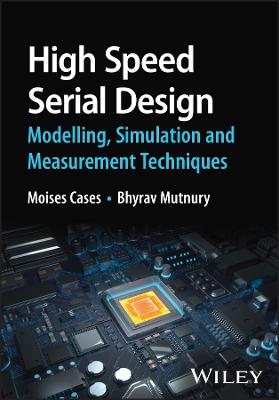Defected Ground Structure (DGS) Based Antennas
 -15%
portes grátis
-15%
portes grátis
Defected Ground Structure (DGS) Based Antennas
Design Physics, Engineering, and Applications
Biswas, Sujoy; Kumar, Chandrakanta; Guha, Debatosh
John Wiley & Sons Inc
12/2022
320
Dura
Inglês
9781119896180
15 a 20 dias
666
Descrição não disponível.
Preface xi
Acknowledgments xv
1 Introduction to DGS: The Concept and Evolution 1
1.1 Introduction 1
1.2 Evolution of DGS 2
1.3 Definition and Basic Concept 5
1.4 Geometries and Classification 6
1.4.1 Unit Cell DGS 7
1.4.1.1 Dumbbell-Shaped DGS 7
1.4.1.2 Variations of Dumbbell-Shaped DGS 8
1.4.1.3 Spiral-Shaped DGS 12
1.4.1.4 Variations of Spiral-Shaped DGS 13
1.4.1.5 H-Shaped DGS 14
1.4.1.6 U- and V-Shaped DGSs 15
1.4.1.7 Ring-Shaped DGS 15
1.4.1.8 Other DGS Geometries 16
1.4.1.9 Tunable DGS Geometries 18
1.4.2 Periodic Uniform DGS 18
1.4.3 Periodic Nonuniform DGS 20
1.4.4 Asymmetric DGS 22
1.5 An Outline of Applications 23
References 24
2 Theoretical Analysis and Modeling 35
2.1 Introduction 35
2.2 LC and RLC Modeling 35
2.2.1 Equivalent Circuit Parameter Extraction 37
2.2.2 Utilization of the Extracted LC for n-Pole DGS Filter Design 41
Trim Size: 6in x 9in Single Column Guha896180 ftoc.tex V1 - 10/10/2022 8:10pm Page vi
[1]
[1] [1]
[1]
vi Contents
2.2.3 RLC Circuit Modeling 43
2.3 LC Circuit Modeling: Variants and Improvements 44
2.3.1 Pi-Type Equivalent Circuit 44
2.3.2 Modeling of Spiral DGS with Periodic Resonance 46
2.3.3 Modeling of DGS with Aperiodic Stopbands 51
2.3.4 Some Modifications in Modeling Approach 54
2.4 Transmission Line Modeling 55
2.5 Quasistatic Modeling 59
2.5.1 Microstrip Gap Model 62
2.5.2 Microstrip Cross Junction Model 63
2.5.3 Modeling of the Rest Current Paths 64
2.6 Modeling of Isolated DGS for Antenna applications 66
2.7 Comments on the Modeling Techniques 68
References 69
3 DGS for Printed Antenna Feeds 73
3.1 Introduction 73
3.2 Impedance Matching of Antenna Feed Lines 73
3.3 Controlling the Harmonics in Printed Antennas 75
3.3.1 Suppression of Second Harmonic (2f 0) 77
3.3.2 Suppression up to Third Harmonic (3f 0) 79
3.3.3 Suppression up to Fourth Harmonic (4f 0) 84
3.4 Filtering Antenna Using DGS 86
3.5 Improved Isolation Between Antenna Ports 88
3.6 Improvement of Antenna Bandwidth 92
3.6.1 Lowering the Q-Factor 92
3.6.2 Adjusting Higher Resonances 94
3.7 Antenna Miniaturization 94
References 98
4 DGS to Control Orthogonal Modes in a Microstrip Patch for
Cross-Pol Reduction 103
4.1 Introduction 103
4.2 Understanding of Radiating Modes in Microstrip Patches 103
4.2.1 Rectangular Patch 104
4.2.2 Circular Patch 106
4.3 WhatWere the Known Methods to Deal with the Cross-Polarized
Fields? 110
4.4 Suppression of Cross-Polarized Fields by DGS Integration Technique:
Coax-Fed Patches 112
Trim Size: 6in x 9in Single Column Guha896180 ftoc.tex V1 - 10/10/2022 8:10pm Page vii
[1]
[1] [1]
[1]
Contents vii
4.4.1 Controlling the OCDM and Cross-Polarized Radiations in
E-Plane 112
4.4.2 Controlling of TM21 Mode and Cross-Polarized Radiations in Circular
and Elliptical Patches 113
4.4.3 Controlling TM02 Mode in a Rectangular Patch and H-Plane
Cross-Polarized Radiations 116
4.4.4 Visualization of the Modal Fields and the Effect of the DGSs 117
4.4.5 Universal DGS: Applicable to Both Circular and Rectangular Patch
Geometries 123
4.4.6 DGS for Triangular Microstrip Patch 127
4.5 Suppression of Cross-Polarized Fields by DGS Integration Technique:
Microstrip-Fed Patches 128
4.6 RecentWorks and New Trends 133
4.6.1 New DGS Geometries 133
4.6.2 New Design Concept of Substrate Field Symmetry 133
4.6.3 Reconfigurable Grid DGS 136
4.7 New Endeavor: Addressing XP Issues Across Skewed Radiation
Planes 138
4.8 Practical Aspects of DGS-Integrated Antennas 140
References 141
5 Multi Parametric Cross-Polar Sources and DGS-Based
Solution to All Radiation Planes 145
5.1 Background and Introduction 145
5.2 Mathematical Explanations of Cross-Polarized Fields 146
5.2.1 Sources of Ex and Ey Components 147
5.2.2 How to Combat Ey Components 149
5.3 Detailed Investigations in to the XP Sources 151
5.3.1 Rectangular Patch 151
5.3.2 Square and Circular Patches 159
5.4 DGS-Based Designs for Low XP in All Radiation Planes 159
5.4.1 Design of Microstrip Line-Fed Circular Patch Antenna 160
5.4.2 Design of a Coax-Fed Rectangular Patch 161
5.4.3 Designing a Patch with Non-proximal DGS 168
5.5 Conclusion 178
References 178
6 DGS-Based Low Cross-Pol Array Design and
Applications 181
6.1 Introduction 181
6.2 Low Cross-Pol Microstrip Array Design 181
Trim Size: 6in x 9in Single Column Guha896180 ftoc.tex V1 - 10/10/2022 8:10pm Page viii
[1]
[1] [1]
[1]
viii Contents
6.2.1 Coax-Fed Microstrip Array 182
6.2.2 Microstrip Line-Fed Array 185
6.3 Array Design for Reduced Mutual Coupling 193
6.4 DGS-Based Array for Different Applications 193
6.4.1 Elimination of Scan Blindness 194
6.4.2 Millimeter-Wave Imaging with Suppressed XP 194
6.4.3 High-Performance Rectenna Array 196
6.4.4 Enhancement of Scanning Range 197
References 202
7 DGS Based Mutual Coupling Reduction: Microstrip Array,
5G/MIMO, and Millimeter Wave Applications 205
7.1 Introduction 205
7.2 Mutual Coupling Mechanisms 206
7.2.1 Mutual Coupling Through Radiations 206
7.2.2 Mutual Coupling by SurfaceWaves 207
7.2.3 Coupling Through Ground Plane Currents 208
7.3 Known Techniques to Control Mutual Coupling 208
7.4 DGS Based Solutions to Mutual Coupling 209
7.5 Major Applications 217
7.5.1 Elimination of Scan Blindness in Large Arrays 217
7.5.2 Enhancement of Scan Range in Phased Array 218
7.5.3 DGS Based Compact Antennas for 5G/MIMO/MillimeterWave
Applications 221
7.6 Conclusion 231
References 232
8 DGS Applied to Circularly Polarized Antenna Design 239
8.1 Introduction 239
8.2 Basic Principle of CP Generation in a Microstrip Patch 239
8.3 Some Important Aspects and Challenges in CP Designs 242
8.4 DGS Integrated Single-Fed CP Antenna Design 243
8.4.1 Use of Slot-Type DGS 243
8.4.2 Use of Fractal DGS 245
8.4.3 Use of Grid DGS 247
8.4.4 Use of PIN Switch Integrated Reconfigurable DGS 249
8.5 DGS as a Supportive Component to CP Design 252
8.5.1 DGS for Improved Surface Current 252
8.5.2 DGS for Balanced Orthogonal Modes 252
8.5.3 DGS for Optimizing CP Bandwidth 254
8.5.4 DGS for Beam Squint Correction and Improved CP Quality 261
Trim Size: 6in x 9in Single Column Guha896180 ftoc.tex V1 - 10/10/2022 8:10pm Page ix
[1]
[1] [1]
[1]
Contents ix
8.6 Evolving Applications: DGS In SIW-Based CP Antennas 265
References 267
9 DGS Integrated Printed UWB Monopole Antennas 271
9.1 Introduction 271
9.2 Improved Impedance Bandwidth and Multiband Operation 272
9.2.1 Improved Impedance Matching of UWB Antennas 272
9.2.2 DGS Induced Resonances for Improved UWB Operation 277
9.3 Band Notch Characteristics in UWB Antennas 280
9.3.1 DGS Based UWB Antenna to Avoid Interference up to C-Band 280
9.3.2 UWB Antenna for Multi-Notch Band Extending to X-Band 286
9.4 Applications to Band Notch UWB MIMO Antennas 288
9.5 Time Domain Behavior of DGS Based UWB Monopole 293
9.6 Conclusion 295
References 296
Index 301
Acknowledgments xv
1 Introduction to DGS: The Concept and Evolution 1
1.1 Introduction 1
1.2 Evolution of DGS 2
1.3 Definition and Basic Concept 5
1.4 Geometries and Classification 6
1.4.1 Unit Cell DGS 7
1.4.1.1 Dumbbell-Shaped DGS 7
1.4.1.2 Variations of Dumbbell-Shaped DGS 8
1.4.1.3 Spiral-Shaped DGS 12
1.4.1.4 Variations of Spiral-Shaped DGS 13
1.4.1.5 H-Shaped DGS 14
1.4.1.6 U- and V-Shaped DGSs 15
1.4.1.7 Ring-Shaped DGS 15
1.4.1.8 Other DGS Geometries 16
1.4.1.9 Tunable DGS Geometries 18
1.4.2 Periodic Uniform DGS 18
1.4.3 Periodic Nonuniform DGS 20
1.4.4 Asymmetric DGS 22
1.5 An Outline of Applications 23
References 24
2 Theoretical Analysis and Modeling 35
2.1 Introduction 35
2.2 LC and RLC Modeling 35
2.2.1 Equivalent Circuit Parameter Extraction 37
2.2.2 Utilization of the Extracted LC for n-Pole DGS Filter Design 41
Trim Size: 6in x 9in Single Column Guha896180 ftoc.tex V1 - 10/10/2022 8:10pm Page vi
[1]
[1] [1]
[1]
vi Contents
2.2.3 RLC Circuit Modeling 43
2.3 LC Circuit Modeling: Variants and Improvements 44
2.3.1 Pi-Type Equivalent Circuit 44
2.3.2 Modeling of Spiral DGS with Periodic Resonance 46
2.3.3 Modeling of DGS with Aperiodic Stopbands 51
2.3.4 Some Modifications in Modeling Approach 54
2.4 Transmission Line Modeling 55
2.5 Quasistatic Modeling 59
2.5.1 Microstrip Gap Model 62
2.5.2 Microstrip Cross Junction Model 63
2.5.3 Modeling of the Rest Current Paths 64
2.6 Modeling of Isolated DGS for Antenna applications 66
2.7 Comments on the Modeling Techniques 68
References 69
3 DGS for Printed Antenna Feeds 73
3.1 Introduction 73
3.2 Impedance Matching of Antenna Feed Lines 73
3.3 Controlling the Harmonics in Printed Antennas 75
3.3.1 Suppression of Second Harmonic (2f 0) 77
3.3.2 Suppression up to Third Harmonic (3f 0) 79
3.3.3 Suppression up to Fourth Harmonic (4f 0) 84
3.4 Filtering Antenna Using DGS 86
3.5 Improved Isolation Between Antenna Ports 88
3.6 Improvement of Antenna Bandwidth 92
3.6.1 Lowering the Q-Factor 92
3.6.2 Adjusting Higher Resonances 94
3.7 Antenna Miniaturization 94
References 98
4 DGS to Control Orthogonal Modes in a Microstrip Patch for
Cross-Pol Reduction 103
4.1 Introduction 103
4.2 Understanding of Radiating Modes in Microstrip Patches 103
4.2.1 Rectangular Patch 104
4.2.2 Circular Patch 106
4.3 WhatWere the Known Methods to Deal with the Cross-Polarized
Fields? 110
4.4 Suppression of Cross-Polarized Fields by DGS Integration Technique:
Coax-Fed Patches 112
Trim Size: 6in x 9in Single Column Guha896180 ftoc.tex V1 - 10/10/2022 8:10pm Page vii
[1]
[1] [1]
[1]
Contents vii
4.4.1 Controlling the OCDM and Cross-Polarized Radiations in
E-Plane 112
4.4.2 Controlling of TM21 Mode and Cross-Polarized Radiations in Circular
and Elliptical Patches 113
4.4.3 Controlling TM02 Mode in a Rectangular Patch and H-Plane
Cross-Polarized Radiations 116
4.4.4 Visualization of the Modal Fields and the Effect of the DGSs 117
4.4.5 Universal DGS: Applicable to Both Circular and Rectangular Patch
Geometries 123
4.4.6 DGS for Triangular Microstrip Patch 127
4.5 Suppression of Cross-Polarized Fields by DGS Integration Technique:
Microstrip-Fed Patches 128
4.6 RecentWorks and New Trends 133
4.6.1 New DGS Geometries 133
4.6.2 New Design Concept of Substrate Field Symmetry 133
4.6.3 Reconfigurable Grid DGS 136
4.7 New Endeavor: Addressing XP Issues Across Skewed Radiation
Planes 138
4.8 Practical Aspects of DGS-Integrated Antennas 140
References 141
5 Multi Parametric Cross-Polar Sources and DGS-Based
Solution to All Radiation Planes 145
5.1 Background and Introduction 145
5.2 Mathematical Explanations of Cross-Polarized Fields 146
5.2.1 Sources of Ex and Ey Components 147
5.2.2 How to Combat Ey Components 149
5.3 Detailed Investigations in to the XP Sources 151
5.3.1 Rectangular Patch 151
5.3.2 Square and Circular Patches 159
5.4 DGS-Based Designs for Low XP in All Radiation Planes 159
5.4.1 Design of Microstrip Line-Fed Circular Patch Antenna 160
5.4.2 Design of a Coax-Fed Rectangular Patch 161
5.4.3 Designing a Patch with Non-proximal DGS 168
5.5 Conclusion 178
References 178
6 DGS-Based Low Cross-Pol Array Design and
Applications 181
6.1 Introduction 181
6.2 Low Cross-Pol Microstrip Array Design 181
Trim Size: 6in x 9in Single Column Guha896180 ftoc.tex V1 - 10/10/2022 8:10pm Page viii
[1]
[1] [1]
[1]
viii Contents
6.2.1 Coax-Fed Microstrip Array 182
6.2.2 Microstrip Line-Fed Array 185
6.3 Array Design for Reduced Mutual Coupling 193
6.4 DGS-Based Array for Different Applications 193
6.4.1 Elimination of Scan Blindness 194
6.4.2 Millimeter-Wave Imaging with Suppressed XP 194
6.4.3 High-Performance Rectenna Array 196
6.4.4 Enhancement of Scanning Range 197
References 202
7 DGS Based Mutual Coupling Reduction: Microstrip Array,
5G/MIMO, and Millimeter Wave Applications 205
7.1 Introduction 205
7.2 Mutual Coupling Mechanisms 206
7.2.1 Mutual Coupling Through Radiations 206
7.2.2 Mutual Coupling by SurfaceWaves 207
7.2.3 Coupling Through Ground Plane Currents 208
7.3 Known Techniques to Control Mutual Coupling 208
7.4 DGS Based Solutions to Mutual Coupling 209
7.5 Major Applications 217
7.5.1 Elimination of Scan Blindness in Large Arrays 217
7.5.2 Enhancement of Scan Range in Phased Array 218
7.5.3 DGS Based Compact Antennas for 5G/MIMO/MillimeterWave
Applications 221
7.6 Conclusion 231
References 232
8 DGS Applied to Circularly Polarized Antenna Design 239
8.1 Introduction 239
8.2 Basic Principle of CP Generation in a Microstrip Patch 239
8.3 Some Important Aspects and Challenges in CP Designs 242
8.4 DGS Integrated Single-Fed CP Antenna Design 243
8.4.1 Use of Slot-Type DGS 243
8.4.2 Use of Fractal DGS 245
8.4.3 Use of Grid DGS 247
8.4.4 Use of PIN Switch Integrated Reconfigurable DGS 249
8.5 DGS as a Supportive Component to CP Design 252
8.5.1 DGS for Improved Surface Current 252
8.5.2 DGS for Balanced Orthogonal Modes 252
8.5.3 DGS for Optimizing CP Bandwidth 254
8.5.4 DGS for Beam Squint Correction and Improved CP Quality 261
Trim Size: 6in x 9in Single Column Guha896180 ftoc.tex V1 - 10/10/2022 8:10pm Page ix
[1]
[1] [1]
[1]
Contents ix
8.6 Evolving Applications: DGS In SIW-Based CP Antennas 265
References 267
9 DGS Integrated Printed UWB Monopole Antennas 271
9.1 Introduction 271
9.2 Improved Impedance Bandwidth and Multiband Operation 272
9.2.1 Improved Impedance Matching of UWB Antennas 272
9.2.2 DGS Induced Resonances for Improved UWB Operation 277
9.3 Band Notch Characteristics in UWB Antennas 280
9.3.1 DGS Based UWB Antenna to Avoid Interference up to C-Band 280
9.3.2 UWB Antenna for Multi-Notch Band Extending to X-Band 286
9.4 Applications to Band Notch UWB MIMO Antennas 288
9.5 Time Domain Behavior of DGS Based UWB Monopole 293
9.6 Conclusion 295
References 296
Index 301
Este título pertence ao(s) assunto(s) indicados(s). Para ver outros títulos clique no assunto desejado.
Dgs; dgs theory; dgs modeling; defected ground structure modeling; defected ground structure theory; dgs antennas; defected ground structure antennas; dgs control; defected ground structure control; printed antenna feeds; printed monopoles
Preface xi
Acknowledgments xv
1 Introduction to DGS: The Concept and Evolution 1
1.1 Introduction 1
1.2 Evolution of DGS 2
1.3 Definition and Basic Concept 5
1.4 Geometries and Classification 6
1.4.1 Unit Cell DGS 7
1.4.1.1 Dumbbell-Shaped DGS 7
1.4.1.2 Variations of Dumbbell-Shaped DGS 8
1.4.1.3 Spiral-Shaped DGS 12
1.4.1.4 Variations of Spiral-Shaped DGS 13
1.4.1.5 H-Shaped DGS 14
1.4.1.6 U- and V-Shaped DGSs 15
1.4.1.7 Ring-Shaped DGS 15
1.4.1.8 Other DGS Geometries 16
1.4.1.9 Tunable DGS Geometries 18
1.4.2 Periodic Uniform DGS 18
1.4.3 Periodic Nonuniform DGS 20
1.4.4 Asymmetric DGS 22
1.5 An Outline of Applications 23
References 24
2 Theoretical Analysis and Modeling 35
2.1 Introduction 35
2.2 LC and RLC Modeling 35
2.2.1 Equivalent Circuit Parameter Extraction 37
2.2.2 Utilization of the Extracted LC for n-Pole DGS Filter Design 41
Trim Size: 6in x 9in Single Column Guha896180 ftoc.tex V1 - 10/10/2022 8:10pm Page vi
[1]
[1] [1]
[1]
vi Contents
2.2.3 RLC Circuit Modeling 43
2.3 LC Circuit Modeling: Variants and Improvements 44
2.3.1 Pi-Type Equivalent Circuit 44
2.3.2 Modeling of Spiral DGS with Periodic Resonance 46
2.3.3 Modeling of DGS with Aperiodic Stopbands 51
2.3.4 Some Modifications in Modeling Approach 54
2.4 Transmission Line Modeling 55
2.5 Quasistatic Modeling 59
2.5.1 Microstrip Gap Model 62
2.5.2 Microstrip Cross Junction Model 63
2.5.3 Modeling of the Rest Current Paths 64
2.6 Modeling of Isolated DGS for Antenna applications 66
2.7 Comments on the Modeling Techniques 68
References 69
3 DGS for Printed Antenna Feeds 73
3.1 Introduction 73
3.2 Impedance Matching of Antenna Feed Lines 73
3.3 Controlling the Harmonics in Printed Antennas 75
3.3.1 Suppression of Second Harmonic (2f 0) 77
3.3.2 Suppression up to Third Harmonic (3f 0) 79
3.3.3 Suppression up to Fourth Harmonic (4f 0) 84
3.4 Filtering Antenna Using DGS 86
3.5 Improved Isolation Between Antenna Ports 88
3.6 Improvement of Antenna Bandwidth 92
3.6.1 Lowering the Q-Factor 92
3.6.2 Adjusting Higher Resonances 94
3.7 Antenna Miniaturization 94
References 98
4 DGS to Control Orthogonal Modes in a Microstrip Patch for
Cross-Pol Reduction 103
4.1 Introduction 103
4.2 Understanding of Radiating Modes in Microstrip Patches 103
4.2.1 Rectangular Patch 104
4.2.2 Circular Patch 106
4.3 WhatWere the Known Methods to Deal with the Cross-Polarized
Fields? 110
4.4 Suppression of Cross-Polarized Fields by DGS Integration Technique:
Coax-Fed Patches 112
Trim Size: 6in x 9in Single Column Guha896180 ftoc.tex V1 - 10/10/2022 8:10pm Page vii
[1]
[1] [1]
[1]
Contents vii
4.4.1 Controlling the OCDM and Cross-Polarized Radiations in
E-Plane 112
4.4.2 Controlling of TM21 Mode and Cross-Polarized Radiations in Circular
and Elliptical Patches 113
4.4.3 Controlling TM02 Mode in a Rectangular Patch and H-Plane
Cross-Polarized Radiations 116
4.4.4 Visualization of the Modal Fields and the Effect of the DGSs 117
4.4.5 Universal DGS: Applicable to Both Circular and Rectangular Patch
Geometries 123
4.4.6 DGS for Triangular Microstrip Patch 127
4.5 Suppression of Cross-Polarized Fields by DGS Integration Technique:
Microstrip-Fed Patches 128
4.6 RecentWorks and New Trends 133
4.6.1 New DGS Geometries 133
4.6.2 New Design Concept of Substrate Field Symmetry 133
4.6.3 Reconfigurable Grid DGS 136
4.7 New Endeavor: Addressing XP Issues Across Skewed Radiation
Planes 138
4.8 Practical Aspects of DGS-Integrated Antennas 140
References 141
5 Multi Parametric Cross-Polar Sources and DGS-Based
Solution to All Radiation Planes 145
5.1 Background and Introduction 145
5.2 Mathematical Explanations of Cross-Polarized Fields 146
5.2.1 Sources of Ex and Ey Components 147
5.2.2 How to Combat Ey Components 149
5.3 Detailed Investigations in to the XP Sources 151
5.3.1 Rectangular Patch 151
5.3.2 Square and Circular Patches 159
5.4 DGS-Based Designs for Low XP in All Radiation Planes 159
5.4.1 Design of Microstrip Line-Fed Circular Patch Antenna 160
5.4.2 Design of a Coax-Fed Rectangular Patch 161
5.4.3 Designing a Patch with Non-proximal DGS 168
5.5 Conclusion 178
References 178
6 DGS-Based Low Cross-Pol Array Design and
Applications 181
6.1 Introduction 181
6.2 Low Cross-Pol Microstrip Array Design 181
Trim Size: 6in x 9in Single Column Guha896180 ftoc.tex V1 - 10/10/2022 8:10pm Page viii
[1]
[1] [1]
[1]
viii Contents
6.2.1 Coax-Fed Microstrip Array 182
6.2.2 Microstrip Line-Fed Array 185
6.3 Array Design for Reduced Mutual Coupling 193
6.4 DGS-Based Array for Different Applications 193
6.4.1 Elimination of Scan Blindness 194
6.4.2 Millimeter-Wave Imaging with Suppressed XP 194
6.4.3 High-Performance Rectenna Array 196
6.4.4 Enhancement of Scanning Range 197
References 202
7 DGS Based Mutual Coupling Reduction: Microstrip Array,
5G/MIMO, and Millimeter Wave Applications 205
7.1 Introduction 205
7.2 Mutual Coupling Mechanisms 206
7.2.1 Mutual Coupling Through Radiations 206
7.2.2 Mutual Coupling by SurfaceWaves 207
7.2.3 Coupling Through Ground Plane Currents 208
7.3 Known Techniques to Control Mutual Coupling 208
7.4 DGS Based Solutions to Mutual Coupling 209
7.5 Major Applications 217
7.5.1 Elimination of Scan Blindness in Large Arrays 217
7.5.2 Enhancement of Scan Range in Phased Array 218
7.5.3 DGS Based Compact Antennas for 5G/MIMO/MillimeterWave
Applications 221
7.6 Conclusion 231
References 232
8 DGS Applied to Circularly Polarized Antenna Design 239
8.1 Introduction 239
8.2 Basic Principle of CP Generation in a Microstrip Patch 239
8.3 Some Important Aspects and Challenges in CP Designs 242
8.4 DGS Integrated Single-Fed CP Antenna Design 243
8.4.1 Use of Slot-Type DGS 243
8.4.2 Use of Fractal DGS 245
8.4.3 Use of Grid DGS 247
8.4.4 Use of PIN Switch Integrated Reconfigurable DGS 249
8.5 DGS as a Supportive Component to CP Design 252
8.5.1 DGS for Improved Surface Current 252
8.5.2 DGS for Balanced Orthogonal Modes 252
8.5.3 DGS for Optimizing CP Bandwidth 254
8.5.4 DGS for Beam Squint Correction and Improved CP Quality 261
Trim Size: 6in x 9in Single Column Guha896180 ftoc.tex V1 - 10/10/2022 8:10pm Page ix
[1]
[1] [1]
[1]
Contents ix
8.6 Evolving Applications: DGS In SIW-Based CP Antennas 265
References 267
9 DGS Integrated Printed UWB Monopole Antennas 271
9.1 Introduction 271
9.2 Improved Impedance Bandwidth and Multiband Operation 272
9.2.1 Improved Impedance Matching of UWB Antennas 272
9.2.2 DGS Induced Resonances for Improved UWB Operation 277
9.3 Band Notch Characteristics in UWB Antennas 280
9.3.1 DGS Based UWB Antenna to Avoid Interference up to C-Band 280
9.3.2 UWB Antenna for Multi-Notch Band Extending to X-Band 286
9.4 Applications to Band Notch UWB MIMO Antennas 288
9.5 Time Domain Behavior of DGS Based UWB Monopole 293
9.6 Conclusion 295
References 296
Index 301
Acknowledgments xv
1 Introduction to DGS: The Concept and Evolution 1
1.1 Introduction 1
1.2 Evolution of DGS 2
1.3 Definition and Basic Concept 5
1.4 Geometries and Classification 6
1.4.1 Unit Cell DGS 7
1.4.1.1 Dumbbell-Shaped DGS 7
1.4.1.2 Variations of Dumbbell-Shaped DGS 8
1.4.1.3 Spiral-Shaped DGS 12
1.4.1.4 Variations of Spiral-Shaped DGS 13
1.4.1.5 H-Shaped DGS 14
1.4.1.6 U- and V-Shaped DGSs 15
1.4.1.7 Ring-Shaped DGS 15
1.4.1.8 Other DGS Geometries 16
1.4.1.9 Tunable DGS Geometries 18
1.4.2 Periodic Uniform DGS 18
1.4.3 Periodic Nonuniform DGS 20
1.4.4 Asymmetric DGS 22
1.5 An Outline of Applications 23
References 24
2 Theoretical Analysis and Modeling 35
2.1 Introduction 35
2.2 LC and RLC Modeling 35
2.2.1 Equivalent Circuit Parameter Extraction 37
2.2.2 Utilization of the Extracted LC for n-Pole DGS Filter Design 41
Trim Size: 6in x 9in Single Column Guha896180 ftoc.tex V1 - 10/10/2022 8:10pm Page vi
[1]
[1] [1]
[1]
vi Contents
2.2.3 RLC Circuit Modeling 43
2.3 LC Circuit Modeling: Variants and Improvements 44
2.3.1 Pi-Type Equivalent Circuit 44
2.3.2 Modeling of Spiral DGS with Periodic Resonance 46
2.3.3 Modeling of DGS with Aperiodic Stopbands 51
2.3.4 Some Modifications in Modeling Approach 54
2.4 Transmission Line Modeling 55
2.5 Quasistatic Modeling 59
2.5.1 Microstrip Gap Model 62
2.5.2 Microstrip Cross Junction Model 63
2.5.3 Modeling of the Rest Current Paths 64
2.6 Modeling of Isolated DGS for Antenna applications 66
2.7 Comments on the Modeling Techniques 68
References 69
3 DGS for Printed Antenna Feeds 73
3.1 Introduction 73
3.2 Impedance Matching of Antenna Feed Lines 73
3.3 Controlling the Harmonics in Printed Antennas 75
3.3.1 Suppression of Second Harmonic (2f 0) 77
3.3.2 Suppression up to Third Harmonic (3f 0) 79
3.3.3 Suppression up to Fourth Harmonic (4f 0) 84
3.4 Filtering Antenna Using DGS 86
3.5 Improved Isolation Between Antenna Ports 88
3.6 Improvement of Antenna Bandwidth 92
3.6.1 Lowering the Q-Factor 92
3.6.2 Adjusting Higher Resonances 94
3.7 Antenna Miniaturization 94
References 98
4 DGS to Control Orthogonal Modes in a Microstrip Patch for
Cross-Pol Reduction 103
4.1 Introduction 103
4.2 Understanding of Radiating Modes in Microstrip Patches 103
4.2.1 Rectangular Patch 104
4.2.2 Circular Patch 106
4.3 WhatWere the Known Methods to Deal with the Cross-Polarized
Fields? 110
4.4 Suppression of Cross-Polarized Fields by DGS Integration Technique:
Coax-Fed Patches 112
Trim Size: 6in x 9in Single Column Guha896180 ftoc.tex V1 - 10/10/2022 8:10pm Page vii
[1]
[1] [1]
[1]
Contents vii
4.4.1 Controlling the OCDM and Cross-Polarized Radiations in
E-Plane 112
4.4.2 Controlling of TM21 Mode and Cross-Polarized Radiations in Circular
and Elliptical Patches 113
4.4.3 Controlling TM02 Mode in a Rectangular Patch and H-Plane
Cross-Polarized Radiations 116
4.4.4 Visualization of the Modal Fields and the Effect of the DGSs 117
4.4.5 Universal DGS: Applicable to Both Circular and Rectangular Patch
Geometries 123
4.4.6 DGS for Triangular Microstrip Patch 127
4.5 Suppression of Cross-Polarized Fields by DGS Integration Technique:
Microstrip-Fed Patches 128
4.6 RecentWorks and New Trends 133
4.6.1 New DGS Geometries 133
4.6.2 New Design Concept of Substrate Field Symmetry 133
4.6.3 Reconfigurable Grid DGS 136
4.7 New Endeavor: Addressing XP Issues Across Skewed Radiation
Planes 138
4.8 Practical Aspects of DGS-Integrated Antennas 140
References 141
5 Multi Parametric Cross-Polar Sources and DGS-Based
Solution to All Radiation Planes 145
5.1 Background and Introduction 145
5.2 Mathematical Explanations of Cross-Polarized Fields 146
5.2.1 Sources of Ex and Ey Components 147
5.2.2 How to Combat Ey Components 149
5.3 Detailed Investigations in to the XP Sources 151
5.3.1 Rectangular Patch 151
5.3.2 Square and Circular Patches 159
5.4 DGS-Based Designs for Low XP in All Radiation Planes 159
5.4.1 Design of Microstrip Line-Fed Circular Patch Antenna 160
5.4.2 Design of a Coax-Fed Rectangular Patch 161
5.4.3 Designing a Patch with Non-proximal DGS 168
5.5 Conclusion 178
References 178
6 DGS-Based Low Cross-Pol Array Design and
Applications 181
6.1 Introduction 181
6.2 Low Cross-Pol Microstrip Array Design 181
Trim Size: 6in x 9in Single Column Guha896180 ftoc.tex V1 - 10/10/2022 8:10pm Page viii
[1]
[1] [1]
[1]
viii Contents
6.2.1 Coax-Fed Microstrip Array 182
6.2.2 Microstrip Line-Fed Array 185
6.3 Array Design for Reduced Mutual Coupling 193
6.4 DGS-Based Array for Different Applications 193
6.4.1 Elimination of Scan Blindness 194
6.4.2 Millimeter-Wave Imaging with Suppressed XP 194
6.4.3 High-Performance Rectenna Array 196
6.4.4 Enhancement of Scanning Range 197
References 202
7 DGS Based Mutual Coupling Reduction: Microstrip Array,
5G/MIMO, and Millimeter Wave Applications 205
7.1 Introduction 205
7.2 Mutual Coupling Mechanisms 206
7.2.1 Mutual Coupling Through Radiations 206
7.2.2 Mutual Coupling by SurfaceWaves 207
7.2.3 Coupling Through Ground Plane Currents 208
7.3 Known Techniques to Control Mutual Coupling 208
7.4 DGS Based Solutions to Mutual Coupling 209
7.5 Major Applications 217
7.5.1 Elimination of Scan Blindness in Large Arrays 217
7.5.2 Enhancement of Scan Range in Phased Array 218
7.5.3 DGS Based Compact Antennas for 5G/MIMO/MillimeterWave
Applications 221
7.6 Conclusion 231
References 232
8 DGS Applied to Circularly Polarized Antenna Design 239
8.1 Introduction 239
8.2 Basic Principle of CP Generation in a Microstrip Patch 239
8.3 Some Important Aspects and Challenges in CP Designs 242
8.4 DGS Integrated Single-Fed CP Antenna Design 243
8.4.1 Use of Slot-Type DGS 243
8.4.2 Use of Fractal DGS 245
8.4.3 Use of Grid DGS 247
8.4.4 Use of PIN Switch Integrated Reconfigurable DGS 249
8.5 DGS as a Supportive Component to CP Design 252
8.5.1 DGS for Improved Surface Current 252
8.5.2 DGS for Balanced Orthogonal Modes 252
8.5.3 DGS for Optimizing CP Bandwidth 254
8.5.4 DGS for Beam Squint Correction and Improved CP Quality 261
Trim Size: 6in x 9in Single Column Guha896180 ftoc.tex V1 - 10/10/2022 8:10pm Page ix
[1]
[1] [1]
[1]
Contents ix
8.6 Evolving Applications: DGS In SIW-Based CP Antennas 265
References 267
9 DGS Integrated Printed UWB Monopole Antennas 271
9.1 Introduction 271
9.2 Improved Impedance Bandwidth and Multiband Operation 272
9.2.1 Improved Impedance Matching of UWB Antennas 272
9.2.2 DGS Induced Resonances for Improved UWB Operation 277
9.3 Band Notch Characteristics in UWB Antennas 280
9.3.1 DGS Based UWB Antenna to Avoid Interference up to C-Band 280
9.3.2 UWB Antenna for Multi-Notch Band Extending to X-Band 286
9.4 Applications to Band Notch UWB MIMO Antennas 288
9.5 Time Domain Behavior of DGS Based UWB Monopole 293
9.6 Conclusion 295
References 296
Index 301
Este título pertence ao(s) assunto(s) indicados(s). Para ver outros títulos clique no assunto desejado.







